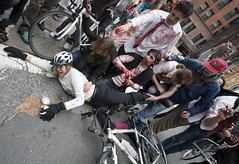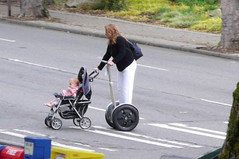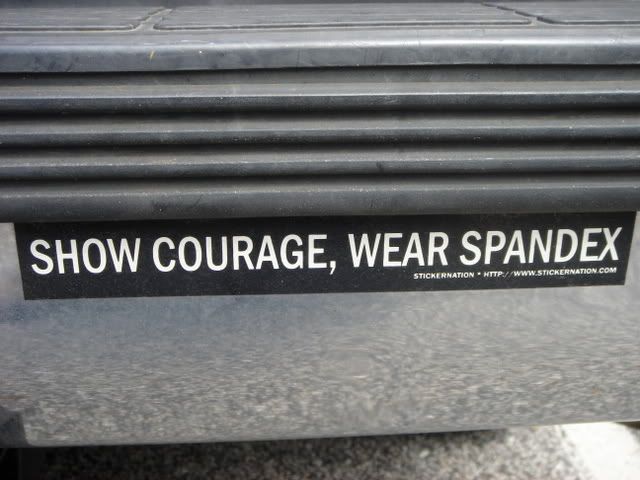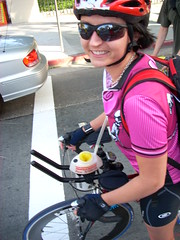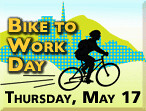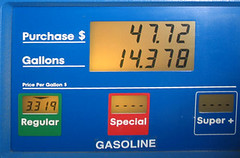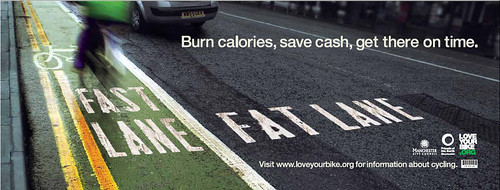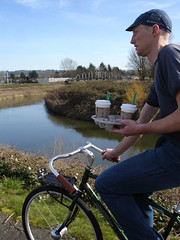I read an article today from the
Madison Capital Times titled "
Bike helmet crushed, but head fine." In brief, a cyclist was proceeding through an intersection in a
bicycle lane when a truck suddenly made a right turn in front of him. He attempted to stop, but ended up being thrown off the bike and under the wheels of the truck. The truck
ran over his head as it rounded the corner. Miraculously, thanks to his helmet, the cyclist was fine.
This is the
exact kind of accident that bicycle lanes cause.
A bicycle lane creates the impression, particularly in the inexperienced and/or poorly educated cyclist's mind, that "
this is where bicycles belong,
not in the travel lanes with the motorists." Further, many non-cyclists think that the presence of a bicycle lane makes it
illegal for the cyclist to use the regular travel lanes or, for that matter, for the
motorist to use the
bicycle lanes.
None of these beliefs are true.
The cyclist in the above article obviously intended to proceed
straight through the intersection. If that was the case, his
proper position was in the
center of the through lane, not at the extreme right. If a cyclist stays too far right when proceeding straight at an intersection, they
invite motorists to squeeze by and turn right into their path, and that's just what happened. This error is so common, it even has a name: a "
right hook."
Further, a cyclist making a
left turn at an intersection must shoulder check, signal and merge into the left turn lane or, on a two lane street, merge to the left side of the lane near the center line, in preparation for a left turn
regardless of the presence of a bike lane. Again, inexperienced cyclists and non-cyclists don't tend to realize this, either.
That's the problem with cycle lanes. They
are usually painted at the extreme right. This tends to guide the inexperienced cyclist to stay right
all the time, even when it's not appropriate to do so. For that matter, if a cycle lane is somehow damaged, filled with debris or is situated in the "
door zone" along parked cars, a cyclist
does have the right to choose to ignore the bike lane
altogether and use the main travel lanes for their safety.
"Why should cyclists be allowed in
our lanes?" many motorists would argue. "We're not allowed in
their lanes."
Surprisingly,
that isn't true, either...
A
motorist intending to make a
right turn at an intersection with a bike lane is
required to
merge into the bike lane in preparation for the turn, just as they would if the cycle lane was an ordinary right turn lane
. By doing so, the motorist signals clearly to any cyclist approaching from behind that he or she intends
to turn right, thus preventing the cyclist from riding up alongside them and getting right hooked.
So, not only are cyclists not supposed to stay
in the bike lane all the time, neither do motorists have to stay
out of it all the time. Choice of lane, particularly
at intersections, is all about your
destination, not the vehicle you're driving.
Accidents like the one above are among the many reasons why I think cycle lanes are useless, and can be downright
dangerous if people aren't properly educated in how to
use them. Under certain conditions, there
are rules that allow motorists to share the cyclists' lane and the cyclists to share the motorists' lanes. If you just paint the cycle lanes
without providing education on how to
use them safely, accidents like the above are inevitable.
This is
also why I feel that cycle lanes only complicate matters, adding additional rules that motorists and cyclists must learn that really aren't necessary. A road with ordinary travel lanes is already an elegant means for
all vehicles to share the road, provided everyone follows the rules and is patient with the varying operating characteristics of the wide variety of vehicles out there.
This was obviously an inexperienced cyclist traveling too fast for his experience level. The fact that he flipped himself over the handlebars suggests he didn't know how to modulate his front brake in an emergency stop and, if he was
unable to stop in time, he should have executed a
quick turn with the truck to avoid the collision instead of trying to stop, anyway. The cycle lane only made things worse by encouraging him to stay too far to the right.
I maintain, and I will
always maintain, that there is only
one way to increase the safety of cyclists on North America's roads:
education. Cyclists and motorists alike
must be made to understand the cyclists
are vehicle operators with the same rights
and responsibilities as
any user of the road.
If we can get
that message out, we won't
need any special lanes for cyclists.




